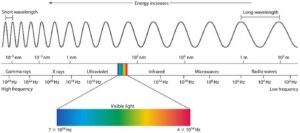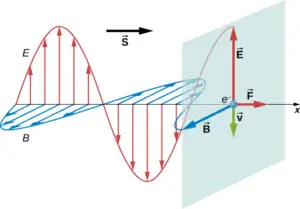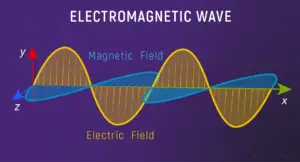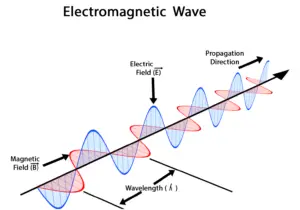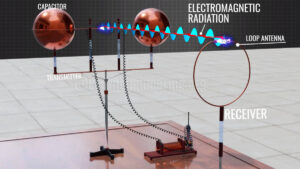In this article, we will discuss some important properties of electromagnetic waves. So let’s get started…
What are electromagnetic waves?
Electromagnetic waves are a type of wave that consists of oscillating electric and magnetic fields and are also known as electromagnetic radiation or EM waves. They are produced by the acceleration of charged particles, such as electrons, and propagate through space at the speed of light.

Electromagnetic waves include a wide range of wavelengths and frequencies, from radio waves at the low-frequency end to gamma rays at the high-frequency end. Some examples of electromagnetic waves include visible light, microwaves, X-rays, and radio waves. Electromagnetic waves do not require a medium to propagate, meaning they can travel through a vacuum or through any type of material, including air, water, and solid objects.
Read Also:
Properties of electromagnetic waves, class 12
Electromagnetic waves are a type of transverse wave that propagates through a vacuum or through a medium, such as air or water. They are made up of changing electric and magnetic fields that oscillate perpendicular to each other and to the direction of propagation.
Here are some properties of electromagnetic waves:
- Electromagnetic waves travel at the speed of light in a vacuum, which is approximately 299,792,458 meters per second.
- Electromagnetic waves are transverse in nature, which means that the oscillations of the electric and magnetic fields are perpendicular to the direction of the wave’s propagation.
- Electromagnetic waves can be described by their frequency, wavelength, and amplitude. Frequency is the number of oscillations per second, measured in Hertz (Hz). Wavelength is the distance between two adjacent peaks or troughs of the wave, measured in meters (m). Amplitude is the maximum displacement of the wave from its equilibrium position.
- Electromagnetic waves do not require a medium to propagate. They can travel through a vacuum or through any type of material, including air, water, and solid objects.
- Electromagnetic waves can be absorbed, reflected, refracted, or diffracted when they encounter a boundary between two different materials.
- Electromagnetic waves can be polarized, which means that the oscillations of the electric and magnetic fields are confined to a particular plane. Polarization can be either linear, circular, or elliptical.
- Electromagnetic waves can be produced by accelerating electric charges, such as electrons in an antenna, or by changing magnetic fields, such as in a transformer.
- Electromagnetic waves can interact with matter in various ways, such as ionizing atoms and molecules, causing chemical reactions, or heating up objects. These interactions are the basis of many technological applications, such as communication, medical imaging, and energy production.
- The oscillations of $\vec{E}$ and $\vec{B}$ fields are in the same phase.
- All electromagnetic waves travel in free space at the same speed,$$c=\frac{1}{\sqrt{\mu_0 \varepsilon_0}} \simeq 3 \times 10^8 \mathrm{~ms}^{-1}$$
- In a material medium, electromagnetic waves travel with the speed, $$v=\frac{1}{\sqrt{\mu \varepsilon}}=\frac{c}{\sqrt{\mu_r \varepsilon_r}}=\frac{c}{n}$$where $n$ is the refractive index of the medium.
- The amplitude ratio of the electric and magnetic fields is $$\frac{E_0}{B_0}=c=\frac{1}{\sqrt{\mu_0 \varepsilon_0}}$$
- Electromagnetic waves carry energy as they travel through space and this energy is shared equally by the electric and magnetic fields. The average energy density of an e.m. wave is$$u=u_E+u_B=\frac{1}{2}\left[\varepsilon_0 E_0^2+\frac{B_0^2}{\mu_0}\right]$$
- Electromagnetic waves transport linear momentum as they travel through space: $$p=\frac{U}{c} \text {. }$$
- Electromagnetic waves are not deflected by electric and magnetic fields.
- The electric field of an electromagnetic wave is responsible for its optical effects because $E_0>>>B_0$.
Read Also:
- Transformer class 12 – Definition, Types, Working Principle, and Constructions
- Nature of electromagnetic waves, class 12
- Expression for energy and average power stored in a pure capacitor
- Sources of electromagnetic waves, class 12
- Mathematical representation of electromagnetic waves, class 12
- Maxwell’s prediction of electromagnetic waves, class 12
- Derive the formula for Intensity of electromagnetic wave, class 12
- Energy density of electromagnetic wave, class 12
Stay tuned with Laws Of Nature for more useful and interesting content.


